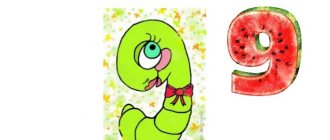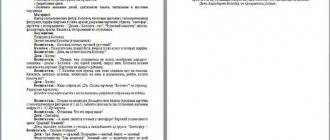Mathematics lesson in the middle group “Number 1”
Summary of an integrated lesson in mathematics in the middle group, topic of the lesson: “Number 1”
Author of the lesson: Svetlana Alekseevna Davydova, teacher-methodologist of the highest qualification category.
Program content:
Introduce children to the number 1, teach them to relate the number to the number of objects. Strengthen the ability to determine spatial location and copy it. Strengthen counting skills and comparing objects by size. Learn to understand a learning task and complete it independently. Will reinforce sculpting techniques: rolling, pressing, pulling. Develop thinking and fine motor skills
Equipment:
Demonstration material: number “1”, subject pictures, typesetting canvas or magnetic board. Handouts: notebooks or sheets of paper, pens, number boxes or number fans, three bricks for each child from a set of building materials, colored pencils, sheets of cardboard, plasticine.
Progress of the lesson:
This number is one. See how proud she is. Do you know why? Starts counting everything. (I. Blyumkin)
The unit or number one is always ahead, it starts the counting. Find number one and show it (children use number boxes or number fans.)
Didactic exercise “Trace and color the number”
Children trace the number with a pen and color it in with a colored pencil.
Didactic exercise “Show one object”
On the ground: Show one finger. Show me one pencil. Show me one brick. At the board or easel: Show one cube, one book, one doll, one ball (pictures).
Didactic exercise “Connect with a line”
Children are asked to connect a circle with the number one and circles with a line. In which one object is drawn. Children are asked questions: “Why didn’t you connect this picture with the number one? How many objects are shown in this picture?
Dynamic pause "Soldiers"
Stand on one leg, as if you were a persistent soldier. Put your left foot to your chest, Look, don’t fall... Now stand on your right, If you are a brave soldier. Now stand on the left, If you are a brave soldier. Once - get up, stretch. Two – bend over, straighten up. Three - three claps of hands, three nods of the head. By four – your arms are wider. Five - wave your arms. Six - sit down quietly.
Didactic game "Repetition"
The teacher places three bars on the table in different positions; after the command “repeat,” the children lay out their bars exactly according to the pattern. The teacher complicates the tasks and reduces the time allotted for completing the task.
Didactic exercise “Geometric shapes”
Here are the fidgety figures who love to play hide and seek. So let's look for them, guys, with our eyes.
Look left, look right, look? Where is the circle? And we found you. Here he is, beloved friend.
Let's all look to the left together. What's there? Where is the square? You prankster cannot escape, from the inquisitive eyes of the guys.
Let's look down and find the triangle there. This is a triangle. Where is the rectangle?
Look in your notebooks and find these figures in them. How many figures are there in total? Which figure is first? Color the square yellow. What figure is next? What is it like? Second. Color the circle red. What figure is next? What is it like? Third. Color the triangle blue. What figure is next? What is it like? Fourth. Color the rectangle with any color you like.
Warm-up for fingers “Baby fingers”
(L. Mukhomorina)
Mom let the kids go for a walk (open your palm, straighten all your fingers). Mom has a lot of them. There are five of these kids! Have you been out for a walk, kids? Now go home! Come quickly, you’re a big finger (the children bend all their fingers one by one), And now you’re attentive, your index finger, And now your middle finger. This is not the last. Ring finger, run to the house
Summary of educational activities on FEMP for children with mental retardation in the senior group of preschool educational institutions. Digit 1
Lesson summary for senior preschool children “The Tale of Number 1”
Brief description: lesson summary on the formation of elementary mathematical concepts using sand therapy. Purpose of the material: the notes can be used by educators, teachers, defectologists and parents. Topic : “The Tale of the Number 1” Purpose: To teach children to perceive the number 1 using various analyzers; draw the number 1 and draw trees using a stencil in the sand. Objectives: - give children the concepts of high-low, higher-lower, equal in height; - consolidate the ability to establish a correspondence between the number of objects and numbers; - consolidate knowledge about number and figure 1. Types of children's activities : cognition, communication, physical development. Planned results : children compare familiar objects in height, are able to draw the number 1 in different ways. Materials and equipment for organizing joint activities: sandbox (light table), stencil of the number 1, stencils of trees, pictures of fruits. Contents of children's organizational activities . Organizing time. Defectologist: Tell me guys, is it possible to confuse the number 1 with other numbers?
Of course not. After all, she is the first and only...(the number 1 is demonstrated); Defectologist: Game “Repeat, don’t make a mistake.” High - low, low - high, high - low - high, high - high - low. Main part.
Defectologist : Game “Higher - Lower”. List the fruits that are above (below). We can say that a pear, an apple, a banana are on the top shelf. — What can you say about the shelf that is located below? (this is the bottom shelf). -List the fruits that are on the bottom shelf. — What fruits are on the top shelf? Defectologist : Today we will go to the fairy tale “The First and Only” (author of the fairy tale: Iris Review). Once upon a time there was a number 1 in the world (we draw the number 1). She was cheerful and cheerful (we draw the sun, and the guys show the emotion). The only sun smiled welcomingly at her, the distant lonely moon illuminated her path in the evenings (we draw the moon). Number 1 could sing and dance well. She was a soloist in the choir. She knew how to sing notes high and beautifully. Edinichka also performed solo in dancing and was always in the foreground. But one day number 1 got bored. - Why do I always walk alone? Yes, I like to be first, I am a leader. I am the personification of uniqueness. But sometimes I feel very sad (children show emotion). And then planet Earth itself told her: “I am alone too. There are no other planets like me in the solar system. But I'm not sad or bored. I have friends - other planets (we draw a planet). And you, dear number 1, also have friends. These are different numbers." “It’s true,” thought Unity. - Why am I sad? I live in one of the best communities - the digital world. We never quarrel or fight. And I am the first and only one in this world. Questions for the fairy tale about the number 1 What was the number 1 usually: cheerful or sad? Why did number 1 get bored one day? Who supported number 1? In what community does number 1 live? Do you think there is a number 1 on other planets? Physical education minute. Children stand on the mat. To the command: “High!” children must jump high; to the command: “Low!” - jump slightly. Defectologist: Game “Find the same height” The teacher draws one tall tree, for example an apple tree. Nearby are stencils of trees of different heights. Children take turns placing stencils next to the apple tree and tracing it, then compare it: this tree is taller, and this one is lower, the same height. Reflection. — Guys, what number did we remember today? — What did you draw on the light table, what did you learn? — What objects did you compare?
We recommend watching:
Summary of GCD for the development of mathematical concepts in the senior group of kindergarten GCD for mathematics in the senior group based on Perrault's fairy tale “Little Red Riding Hood” Summary of GCD for FEMP in the senior group Lesson in mathematics in the senior group. Abstract
Similar articles:
Summary of a mathematics lesson in the senior group of kindergarten. Geometric figures
Summary of a lesson on FEMP in the senior group of a preschool educational institution on the topic: Width of objects
Summary of a lesson on FEMP in the senior group of a preschool educational institution on the topic: Measuring length
Abstract of GCD in mathematics in kindergarten in the senior group on the topic “Ball, cube”
Abstract of GCD in mathematics in kindergarten in the senior group. Length, height, width of objects
Program content
Introduce numbers 1 and 2 and learn to denote numbers with numbers.
Practice counting skills forward and backward within 10.
Strengthen the ability to navigate on a sheet of paper, determine the sides and corners of the sheet.
Improve your understanding of triangles and quadrilaterals.
Didactic visual material
Demonstration material. Cards with numbers 1 and 2, dummies of mushrooms (1 porcini mushroom and 2 aspen mushrooms), 10 triangles of the same color, sample pattern.
Handout. Cards with numbers 1 and 2, rectangles of the same color (10 pieces for each child), sheets of paper, colored pencils.
Guidelines
Part I. Game exercise “Count the mushrooms.”
There are dummies of mushrooms on the teacher’s table: 1 porcini mushroom and 2 aspen mushrooms.
The teacher asks the children the names of the mushrooms and finds out whether they are edible or not. Then he asks: “How many porcini mushrooms?” Who knows what number can be used to represent the number one?”
The teacher shows a card with a picture of the number 1, places it next to the porcini mushroom and asks: “What does the number one look like? Find a card with the number one and circle it with your finger.”
Clarifies: “The number one means the number one.”
Similarly, the teacher introduces children to the number 2.
Part II. Didactic game “Find the same amount.”
The teacher shows the number. Children find the appropriate number of objects in the group and justify their choice. (One watch, two vases, two paintings...)
The teacher clarifies: “The number one (two) shows the number one (two).”
The teacher names the number of objects, the children show the corresponding number.
Part III. Game exercise “Count the figures.”
There are 10 triangles of the same color on the flannelgraph. Children determine their number. Then the teacher asks: “How many triangles will remain if we remove one triangle each time?”
Children, together with the teacher, count the triangles in reverse order (from 10 to 1). The teacher clarifies: “What did we do when we counted from ten to one?”
Part IV. Working with handouts.
Children have ten rectangles. The teacher offers to complete a similar task. Children count the rectangles, remove one at a time and determine how many are left. Together with the teacher, they call the numbers in reverse order. (Ten, nine, eight...one.)
Part V Didactic game “Remember and complete” (auditory dictation).
Children have sheets of paper and colored pencils. The teacher clarifies the name of the sides and corners of the sheet.
Then he gives the children tasks:
1) draw a straight line along the top side of the sheet with a red pencil (along the bottom side with a green pencil, along the left side with a blue pencil, along the right side with a yellow pencil);
2) draw a circle in the upper left corner with a red pencil (in the lower left corner with a blue pencil, in the upper right corner with a yellow pencil, in the lower right corner with a green pencil);
3) put a dot in the middle of the sheet with a red pencil.
Children check the correctness of the task using the teacher’s model.
The teacher clarifies: “What and where did you draw?”
Children name the details, their color and location.



